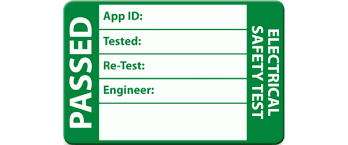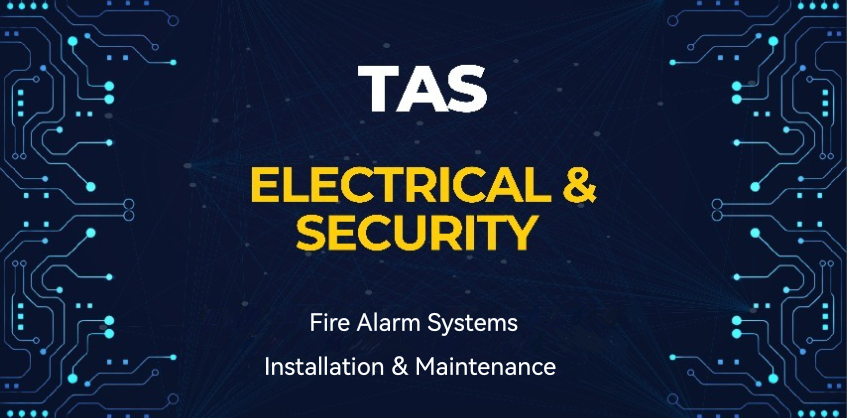| 07830655771 |  |
 |
 |
| Electricians Killamarsh |
Fire Alarm Systems | CCTV Company |
Intruder Alarms |
Access Control |
Emergency Lighting | Nurse Call Systems | PAT Testing |
Security Lighting |
EICR Reports |
Fire Risk Assessments |
 |
With over a decade of NICEIC registration, TAS Electrical and Security is a trusted authority in the field. Specializing in Portable Appliance Testing (PAT), we offer comprehensive services including testing, inspection, and certification. Our expertise spans all types of appliances, ensuring top-notch safety and compliance for diverse settings. Trust TAS Electrical and Security for reliable solutions tailored to your electrical safety needs.
|
 |
At TAS Electrical, we prioritize seamless Portable Appliance Testing (PAT) with minimal disruption to working conditions and property. Our team is dedicated to ensuring efficient procedures that safeguard both productivity and the integrity of your premises. With meticulous planning and execution, we strive to complete testing swiftly and smoothly, allowing you to focus on your operations without interruption. Trust TAS Electrical for expert PAT solutions that prioritize safety and convenience for your environment. |
|
As a landlord or business owner in England, ensuring the safety of your tenants, employees, and property should be a top priority. One essential aspect of this responsibility is Portable Appliance Testing (PAT). Regular PAT ensures that electrical appliances are safe to use, reducing the risk of electrical accidents, fires, and injuries. This blog will delve into why PAT is crucial for landlords and business owners and how it can benefit you. Legal Requirements and ComplianceIn England, there are stringent regulations concerning electrical safety. The Health and Safety at Work Act 1974, the Electricity at Work Regulations 1989, and the Landlord and Tenant Act 1985 all impose duties on landlords and employers to ensure electrical equipment is safe to use. While PAT itself is not a legal requirement, it is widely recognized as an effective way to comply with these regulations. Regular PAT testing helps demonstrate due diligence, ensuring you meet your legal obligations and avoid potential fines or legal action. Safety FirstThe primary purpose of PAT is to prevent electrical accidents. Faulty appliances can cause electric shocks, burns, and even fires. Regular testing identifies potential hazards before they become serious issues, ensuring the safety of everyone on your premises. For landlords, this means providing a safe living environment for tenants. For business owners, it means protecting your employees and customers, fostering a safe workplace, and avoiding costly disruptions caused by accidents. Protecting Your InvestmentFor business owners, faulty electrical appliances can lead to significant downtime, loss of productivity, and financial loss. PAT helps identify issues early, allowing for timely repairs or replacements. This proactive approach minimizes the risk of unexpected equipment failure, helping you maintain smooth operations. For landlords, ensuring that appliances are in good working order can prevent damage to your property, reduce maintenance costs, and enhance the longevity of your electrical systems. Enhancing ReputationSafety is a critical factor for tenants and customers alike. For landlords, providing a safe living environment can enhance your reputation, making your properties more attractive to prospective tenants. Similarly, business owners who prioritize safety can build trust with customers and employees, boosting your business’s reputation. Regular PAT demonstrates a commitment to safety, helping to foster positive relationships and enhance your brand’s image. Insurance BenefitsMany insurance policies for businesses and rental properties require compliance with electrical safety standards. Regular PAT testing can help ensure you meet these requirements, potentially lowering your insurance premiums. In the event of an electrical-related incident, having a record of regular PAT testing can support your insurance claims, helping to avoid disputes and ensure a smoother claims process. Peace of MindKnowing that your electrical appliances are safe to use provides peace of mind. Regular PAT testing means you can be confident that you’ve taken all necessary precautions to protect your tenants, employees, and property. This assurance allows you to focus on other aspects of managing your property or running your business, knowing that electrical safety is in good hands. ConclusionPortable Appliance Testing (PAT) is an invaluable tool for landlords and business owners in England. By ensuring electrical appliances are safe to use, PAT helps prevent accidents, protect investments, enhance reputation, meet legal requirements, and provide peace of mind. Whether you manage rental properties or run a business, regular PAT testing should be a key component of your safety and maintenance strategy. Trust TAS Electrical for expert PAT solutions that prioritize safety and convenience for your environment. |
Pat Testing In Killamarsh |
A Comprehensive Guide To Portable Appliance Testing (PAT) |
Ensuring electrical safety is paramount in any environment, be it residential, commercial, or industrial. Portable Appliance Testing (PAT) plays a crucial role in maintaining this safety by regularly checking the condition of electrical appliances. This comprehensive guide will walk you through everything you need to know about PAT, from its importance to the process and best practices. What is PAT?Portable Appliance Testing (PAT) is a routine inspection and testing process designed to ensure electrical appliances are safe to use. It involves visual inspections, testing for insulation resistance, earth continuity, and other essential checks to identify potential electrical faults. The goal is to prevent electrical accidents, ensuring the safety of users and the integrity of the premises. Why is PAT Important?1. Safety First: The primary reason for PAT is to ensure the safety of individuals using electrical appliances. Faulty appliances can cause electric shocks, burns, or fires. Regular testing helps identify and mitigate these risks. 2. Legal Compliance: In the UK, while PAT is not legally mandated, several regulations require maintaining safe electrical systems. These include the Health and Safety at Work Act 1974, the Electricity at Work Regulations 1989, and the Landlord and Tenant Act 1985. PAT is a widely recognized method for ensuring compliance with these regulations. 3. Preventing Downtime: For businesses, faulty electrical appliances can lead to significant downtime and loss of productivity. Regular PAT helps detect issues early, allowing for timely repairs and reducing the risk of unexpected breakdowns. 4. Insurance Requirements: Many insurance policies for businesses and rental properties require compliance with electrical safety standards. Regular PAT can help meet these requirements, potentially lowering insurance premiums and facilitating smoother claims processes. What Types of Equipment Need PAT?PAT applies to any electrical appliance that can be moved and is connected to the mains supply via a plug. This includes:
The PAT Process1. Visual Inspection: The first step is a thorough visual inspection to check for obvious signs of damage, such as frayed cords, cracked plugs, or exposed wires. The appliance casing and any associated cables are also inspected for wear and tear. 2. Testing: Several electrical tests are conducted using specialized PAT testing equipment:
3. Record Keeping: All test results should be recorded, along with details of the appliance, the date of the test, and the outcome. This documentation is essential for demonstrating compliance and tracking maintenance. 4. Labelling: Once tested, each appliance should be labeled with a pass or fail sticker, indicating the test date and the next scheduled test. How Often Should PAT Be Conducted?The frequency of PAT depends on several factors, including the type of equipment, the environment in which it is used, and the risk level associated with its use. For example:
A risk assessment should be conducted to determine the appropriate testing frequency for each appliance. Best Practices for PAT1. Hire Qualified Professionals: While some aspects of PAT can be conducted by a competent person, it is advisable to hire qualified professionals, especially for more complex testing. They have the expertise and equipment to carry out thorough inspections. 2. Maintain Detailed Records: Keep detailed records of all PAT tests, including test results, maintenance actions taken, and schedules for future tests. This documentation is vital for compliance and for tracking the condition of your appliances. 3. Regular Risk Assessments: Conduct regular risk assessments to evaluate the safety of your electrical appliances and determine appropriate testing intervals. Factors such as the age of the equipment, usage patterns, and the working environment should be considered. 4. Implement a Maintenance Schedule: Establish a regular maintenance schedule for all electrical appliances. This proactive approach helps ensure appliances are kept in good working condition and reduces the risk of unexpected failures. ConclusionPortable Appliance Testing (PAT) is a critical component of electrical safety management. By conducting regular PAT, you can ensure the safety of your electrical appliances, comply with legal requirements, prevent costly downtime, and protect your investment. Whether you're a landlord, business owner, or responsible for workplace safety, understanding and implementing effective PAT practices is essential. Trust TAS Electrical for comprehensive PAT services that prioritize safety, compliance, and convenience. |
Pat Testing In Killamarsh |
Portable Appliance Testing (PAT) In Houses Of Multiple Occupation (HMOs) in The UK |
Houses of Multiple Occupation (HMOs) present unique challenges when it comes to maintaining safety and compliance with regulations. Among these challenges is the need to ensure that all electrical appliances are safe to use. Portable Appliance Testing (PAT) is a crucial aspect of this safety regime, helping to protect tenants and property. This blog explores the importance of PAT in HMOs in the UK, outlining the benefits, legal requirements, and best practices. Understanding HMOs and Their Unique NeedsAn HMO is a property rented out by at least three people who are not from one household (for example, a family) but share facilities like the bathroom and kitchen. Because of the communal living arrangements and the higher turnover of tenants, HMOs have specific regulatory requirements to ensure safety, including fire safety, health and safety, and electrical safety. Why is PAT Important in HMOs?1. Ensuring Tenant Safety: The primary purpose of PAT is to ensure that electrical appliances are safe to use. In HMOs, where multiple tenants share living spaces and electrical appliances, the risk of accidents increases. Regular PAT helps identify and mitigate these risks, ensuring a safe living environment for all tenants. 2. Legal Compliance: In the UK, landlords of HMOs are subject to strict regulations to ensure the safety of their properties. The Management of Houses in Multiple Occupation (England) Regulations 2006 and the Housing Act 2004 impose duties on landlords to maintain electrical installations and appliances in safe working order. Regular PAT is a recognized method of demonstrating compliance with these regulations. 3. Preventing Electrical Fires: Electrical faults are a common cause of fires in residential properties. In an HMO, the use of multiple appliances by several tenants increases the risk. PAT helps identify faulty appliances and prevent potential fire hazards, protecting both tenants and property. 4. Enhancing Property Value and Reputation: A well-maintained HMO that prioritizes safety is more attractive to prospective tenants. Regular PAT not only ensures compliance but also enhances the reputation and value of the property. Tenants are more likely to stay longer and recommend the property to others if they feel safe. Legal Requirements for PAT in HMOsWhile there is no specific legal requirement mandating PAT, landlords of HMOs must ensure that all electrical equipment provided as part of the tenancy is safe. Relevant legislation includes:
Regular PAT is a practical and effective way to comply with these requirements, providing documented evidence of safety checks. The PAT Process for HMOs1. Inventory Check: Start by compiling a comprehensive inventory of all portable electrical appliances in the HMO. This includes items like kettles, microwaves, toasters, and any other equipment provided by the landlord. 2. Visual Inspection: Conduct a thorough visual inspection of each appliance, checking for signs of damage, wear and tear, and any obvious defects. Look for frayed cords, cracked plugs, and other visible issues. 3. Electrical Testing: Use PAT testing equipment to perform a series of tests, including:
4. Record Keeping: Maintain detailed records of all PAT tests, including the date of the test, the results, and any actions taken. This documentation is crucial for demonstrating compliance and scheduling future tests. 5. Labelling: Label each tested appliance with a pass or fail sticker, indicating the test date and the next scheduled test. This provides a clear visual indication of the appliance’s status. Best Practices for PAT in HMOs1. Regular Testing Intervals: Establish a regular testing schedule based on the risk assessment. Higher-risk appliances or those in heavy use may require more frequent testing, such as every six months, while others may be tested annually. 2. Tenant Education: Educate tenants about the importance of electrical safety and encourage them to report any issues with appliances immediately. Provide guidelines on safe appliance use and handling. 3. Professional Testing: While some aspects of PAT can be conducted by a competent person, it is advisable to hire qualified professionals, especially for larger HMOs or those with numerous appliances. Professional testers have the expertise and equipment to ensure thorough and accurate testing. 4. Continuous Monitoring: PAT should be part of a broader electrical safety strategy that includes regular inspections of fixed wiring and other electrical systems. Continuous monitoring helps maintain a high standard of safety. ConclusionPortable Appliance Testing (PAT) is an essential component of electrical safety in Houses of Multiple Occupation (HMOs). By conducting regular PAT, landlords can ensure the safety of their tenants, comply with legal requirements, prevent electrical fires, and enhance the value and reputation of their properties. Implementing best practices and maintaining detailed records will help create a safe and compliant living environment for all tenants. Trust TAS Electrical for expert PAT services tailored to the unique needs of HMOs.
|
Pat Testing In Killamarsh |
Pat Testing In Killamarsh |
Social Media |
Pat Testing In Killamarsh |
 |
| 07830655771 |  |
Pat Testing In Killamarsh |